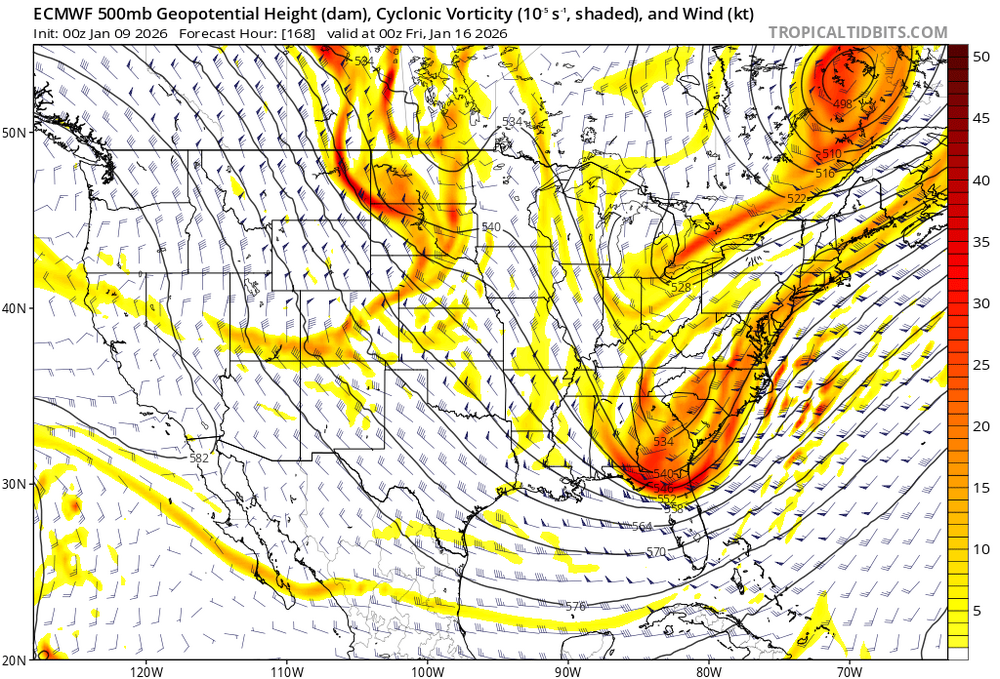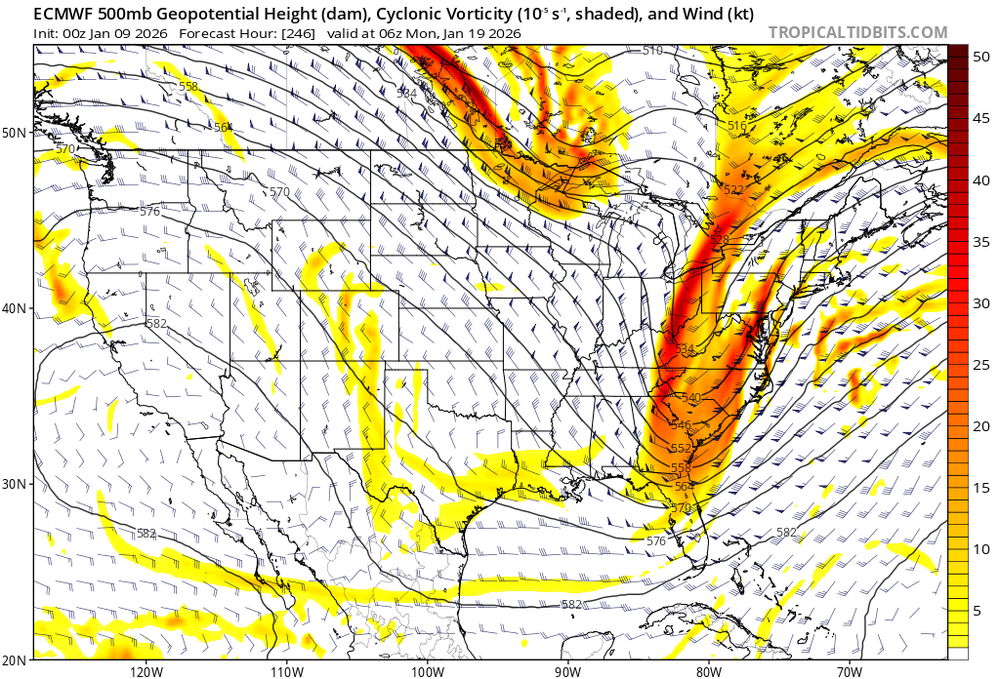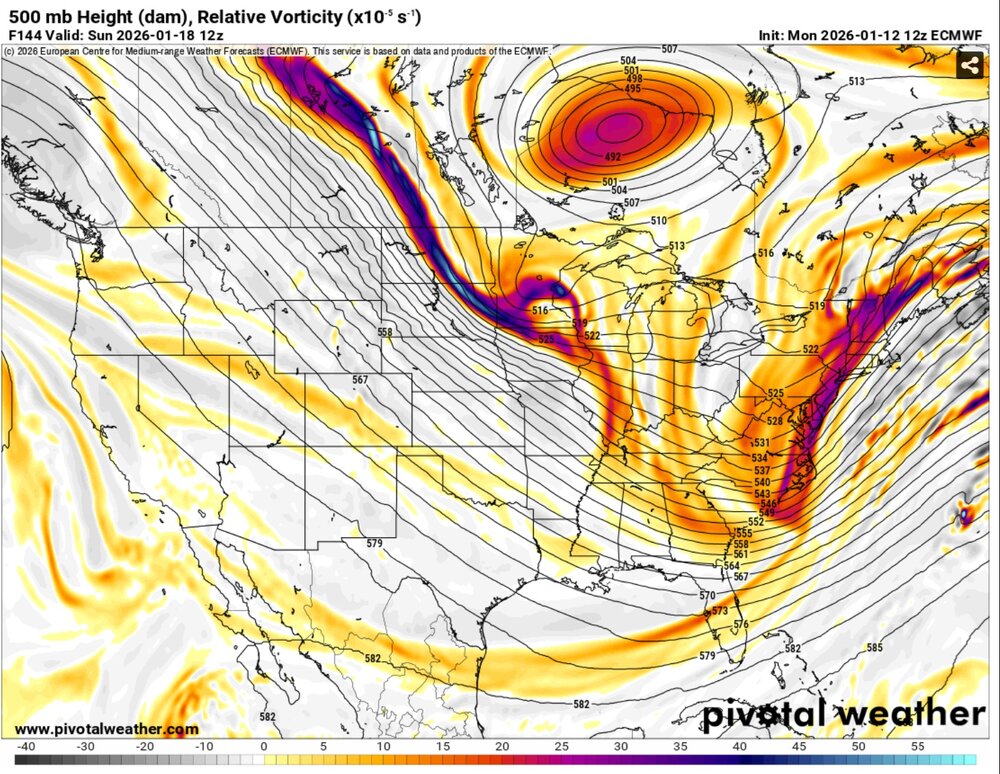
eduggs
Members-
Posts
5,586 -
Joined
-
Last visited
Content Type
Profiles
Blogs
Forums
American Weather
Media Demo
Store
Gallery
Everything posted by eduggs
-
I agree the 1-3" characterization is better. But the event is not quite over for I-95 by 120hrs on the UK. But only a few hundredths of QPF after.
-
I don't really believe in ceilings, especially beyond 24 or 48 hours or so. I remember Feb. 11, 2006 looked like a miss or fringe event 4 days out. 2 days out it looked like a plowable snowfall with a fantasy ceiling of maybe 8". Then the storm dropped 27" at NYC. If the synoptic scale features break right and the small-scale stuff aligns perfectly, sometimes there is no ceiling.
-
The GEFS improved again for Sunday (trof and individual members) even if QPF doesn't fully reflect the improvement.
-
The UK is similar to the GFS, but better. Accumulating snow to the coastal plain just NW of NYC. Nice h5 and surface almost as good as GFS-AI. Great 0z.
-
I'm not really sure what fast flow means here in context. In the past I think it referred to an anomalously strong jet stream across the Pacific that penetrated the North American continent with mild air. "Fast flow" seems to have become a scapegoat when anything fails regardless of cause. In this case the flow is straight out of central Canada and the flow looks seasonably fast, i.e., not too fast. The speed of a SLP is partly dependent on steering currents but also on the structure and degree of maturity of a trof. For example, a SLP may slow and stall near a cutoff upper level low even if the associated jet has winds speeds over 80 knots.
-
I think the 0z GFS is now one decent step away from a plowable snowfall. Last run it was 2 steps away. It's at least starting to look plausible when you loop 500mb
-
The GFS still isn't great for Sunday. A little 12z Canadian like with a mid-level low in the Lakes and a pos tilted trof structure
-
The GFS at 84hrs looks like it has a sharper shortwave with more vorticity crossing into North Dakota. I think that's the vorticity that sharpens the base of the trof a day or so later... we'll see... could be a slightly better trof for Sunday
-
Snows for 30 hours N&W of NYC on the ICON. Seems unlikely but fun to look at. A 6 hour period of steady rain or snow with flurries or light rain with the initial week overrunning seems more plausible.
-
The RDPS looks good at the surface. But at 500mb it looks similar to the 0z GDPS, which developed a cutoff low and curled it into the Lakes. The ICON digs the trof base further south and goes neutral tilt, which is more conducive to a coastal SLP.
-
ICON has snow I-95 N&W on Sun. The RDPS looks decent at 84hrs. Decent start to 0z.
-
There's a 96" in there in SW PA. But about 20" of it is from before/after to big storm.
-
Is cold air ever guaranteed at 41° N and 74° W? I count 3 separate rain events in the LR on both the GFS and ECMWF. In January that can't be that cold. No we don't forecast based on LR OP model runs. But it's risky to guarentee something in the face of directly contradictory evidence.
-
I can't speak for everyone but I suspect if asked today, most would be happy with an average Feb & March even if they finished below normal for the season.
-
See, we don't disagree. This was exactly the point I made 3 days ago that you dismissed. Long-range ensemble modeling hides critical shortwave details. That doesn't mean it shouldn't be used as a forecasting tool. But it does bias long-range "looks" positive because it smooths out wave spacing and interference issues.
-
There's no such rule. Accumulated snowfall is a poor metric for any kind of correlation, especially at an individual location. The complexity and variability of ENSO states also makes reducing it to a binary a poor choice for correlation. It's too early to toss January.
-
I made a perfectly legitimate point. Focus on that instead of me.
-
This ECMWF chart below looks a lot like something "clawing at the back" of the east coast trof for the 18th. This perfectly illustrates my point about being cautious about preferring a later threat based on averaged ensemble height fields.
-
The mid- and long-range continues to look really active for the north country with this clipper parade. And a lot of these events have better than typical dynamics. I can remember plenty of early Januarys that were dry frozen tundras up in the Dacks. Not this year.
-
I think it's more likely he'll present the underlying information that he uses in his analysis. He might also reread some of the citations at the end of the link he posted and sharpen up his own analysis. And then everybody benefits.
-
Look, I don't care how I look on this weather board. And there are certainly many people who know more than I do and whose brains work much faster than mine. I care about truth, facts, evidence, and the scientific method. These are the things that improved human quality of life tremendously over the past few hundred years. When you know what's true and you understand cause and effect, you can make good decisions that benefit people. The opposite is true when you make decisions based on myth, tradition, dogma, voodoo, or a misunderstanding of what's real and true. That's why I have a problem when people anthropomorphize weather features (surface highs/lows, "kickers") or climate indices, because it misleads people about what's actually happening. I'm sensitive to a distortion of facts and partial truths... especially when they are presented with an heir of expertise. That's why I challenge these things. If Don performed a sensitivity analysis that as a byproduct generated a mean (output) value for monthly temperature, then he should either say that or call it something else, like a probability analysis. Words matter. Perceptions matter. The reality is that, sensitivity analysis or not, we don't have a robust method to estimate local temperature beyond 10 days. The uncertainty is huge, particularly at our latitude along the coastal plain in January. To imply that we have a statistical handle on the likely outcome is disingenuous.
-
If he says something incorrect and continues to insist that he is correct, I will challenge it right here. Maybe I'm wrong. Maybe he's wrong. Either way, anybody reading can learn. If I had no respect for him, I would ignore it. People need to know what's true and what's not.
-
Sunday is still on the table for some kind of event. All the ensembles have something. It's workable.
-
Some of us know what a sensitivity analysis is. And for those who do not, your link is helpful. But what you present is not a sensitivity analysis. Or maybe you are withholding most of it, which should include: - which inputs you used in your analysis - how they were perturbed - how the output (mean temp) varied with those perturbations - ranking of influential variables The goal of a sensitivity analysis in to determine which variables have the biggest impact on some output... not just what is the most likely output. And if the variables, assumptions, and their tested ranges aren't included, the output is kind of meaningless.
-
I agree strongly with everything written except this. I believe these features are not causally connected. They are only loosely correlated, and always in hindsight. Besides that, the trof IS clearly sufficiently sharp for a major event. But the synoptic details (which you correctly mention) impede development in a way that would impact us locally.





